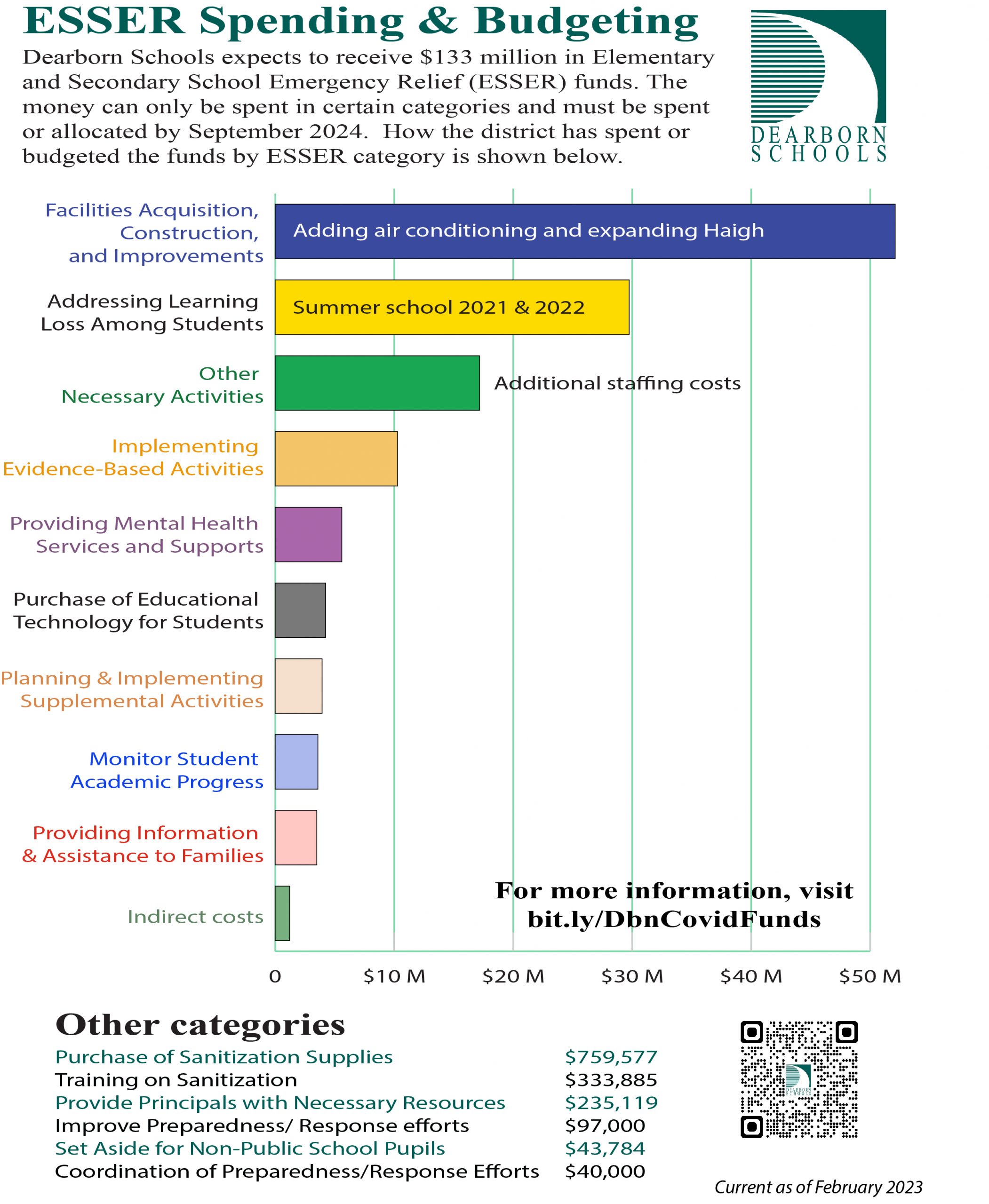Dearborn Public Schools recently updated its financial filings with the state to show the district now plans to spend about $52 million in ESSER funding on buildings, most of that to add air-conditioning at some elementary schools.
A breakdown of how the district has spent or budgeted its entire $133 million in ESSER funding is now posted on the district website, including an updated graphic showing the spending by ESSER category.
The additional $12 million now budgeted from ESSER money for buildings will probably not be enough to allow the district to expand the projects beyond the previously announced nine school – DuVall, Haigh, Howard, Long, Nowlin, Oakman, Snow, Whitmore Bolles and possibly Lindbergh. The additional funds are needed to cover inflation and to hopefully ensure there is enough funding to cover all of the buildings. Lindbergh will only have air-conditioning added if funding permits.
ESSER building funds are also being used to help expand Haigh Elementary, including adding more classrooms and an expanded cafeteria. Some ESSER funding will also assist the district in buying and renovating buildings for the Henry Ford Early College high schools.
Preliminary work to add air-conditioning has already started. Oakman, Duvall, Whitmore Bolles and Snow elementary schools have construction workers adding air ducts a classroom at time. During the week or so workers are in a particular room, that class moves to another space in the building. Adding ducts during the school year will hopefully allow the air-conditioning projects in those buildings to be completed over the summer. (For more on how buildings were selected to have air-conditioning added, please see our December 2022 building update.)
The last of the funding from ESSER, the Elementary and Secondary School Emergency Relief Act, must be allocated by September 2024. The district has already spent all the funding from the first two waves- $8.5 million from ESSER 1 and $38 million from ESSER 2. The district is currently spending and budgeting $86 million from ESSER 3. ESSER funds could only be spent in certain categories. Improved air-handling, including air-conditioning, was one of the few building items that could be paid for with the funding.
About one-third of the district’s school buildings already have air-conditioning including Becker Elementary, Cotter Early Childhood Center, the Dearborn Heights Campus, Geer Park Elementary, Henry Ford Elementary, Miller Elementary, McCollough/Unis, Salina Elementary, Salina Intermediate, Stout Middle (mostly air-conditioned) and William Ford Elementary. Most of these schools were either built or had massive renovations/additions since the 1990s. The ESSER-funded project is the district’s first large-scale work to add air-conditioning to older buildings. In all eight schools slated to receive air conditioning, the district will also be able to make some much needed boiler upgrades using the federal funding.
After the air-conditioning projects, the largest single item in the district’s ESSER budgets was almost $30 million in the category “Addressing Learning Loss Among Students.” Those funds were used for free summer school for students, including $20 million for a robust, all-day program in 2021 and the rest for a more modest summer school program in 2022.
The third largest category was $17 million for what the state termed “Other Activities Necessary to Maintain the Operation/Continuity of Services” in the district. That spending included hiring additional teachers to reduce class sizes and to handle virtual classrooms, extra pay for teachers and administrators working extra time to address student mental health, and bonuses to recruit and retain teachers during a national staffing shortage worsened by the pandemic.
Ongoing expenses like the additional pay and staffing will shift back to the district’s general fund budget next year. That will in turn limit how much the district can use of its regular funding towards building maintenance and improvements.
The district continues to post updates on how it is using federal funding on its COVID Funds page.
“We are very grateful for the influx of federal dollars from ESSER and other COVID-related funding earlier in the pandemic,” said Superintendent Glenn Maleyko. “We have worked hard to use these funds wisely and strategically to tackle issues caused by the pandemic, including hiring more teachers and social workers. But we’ve also tried as much as we could to use that extra funding to address larger issues like chipping away at some building needs in the district.”

